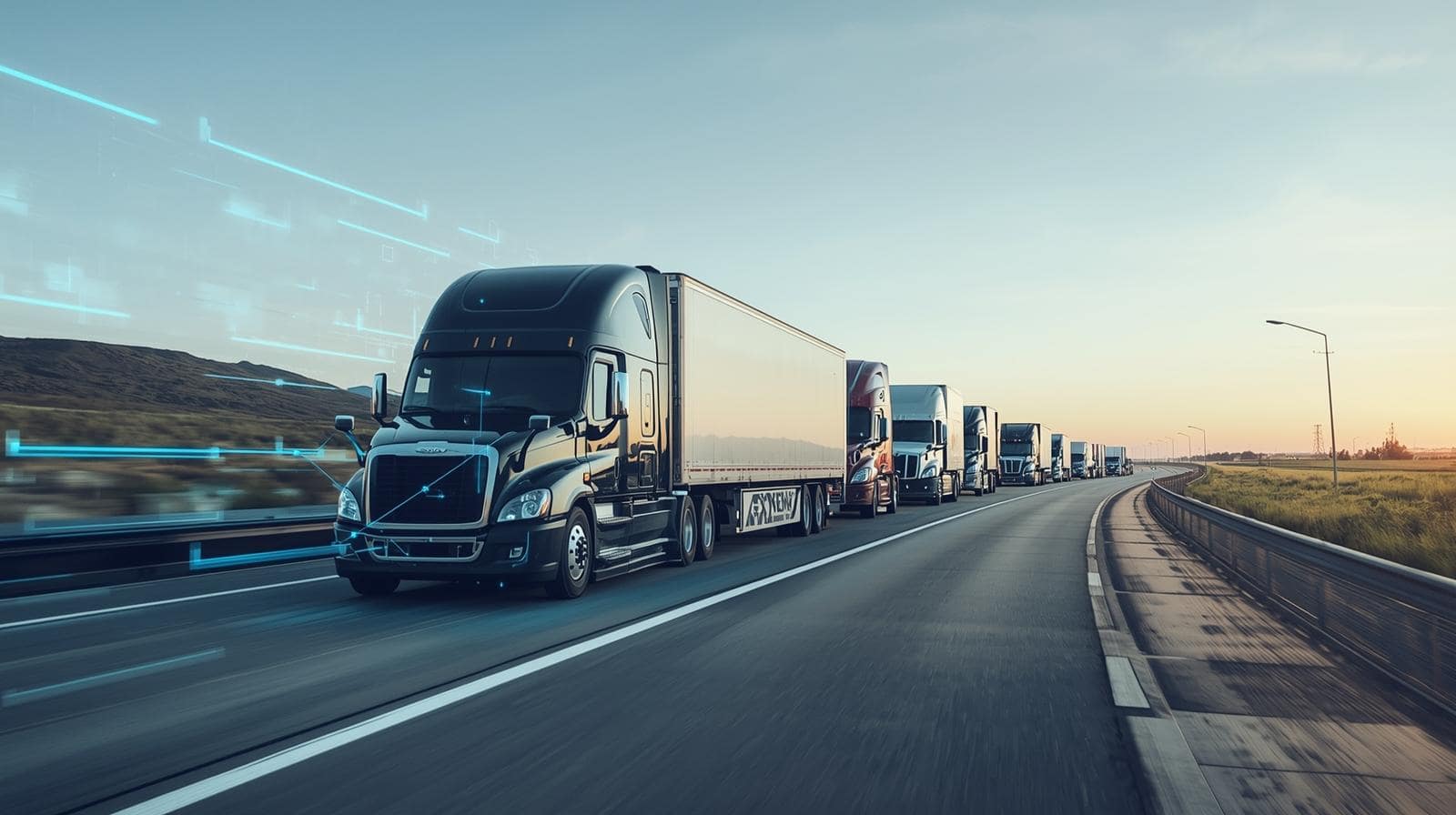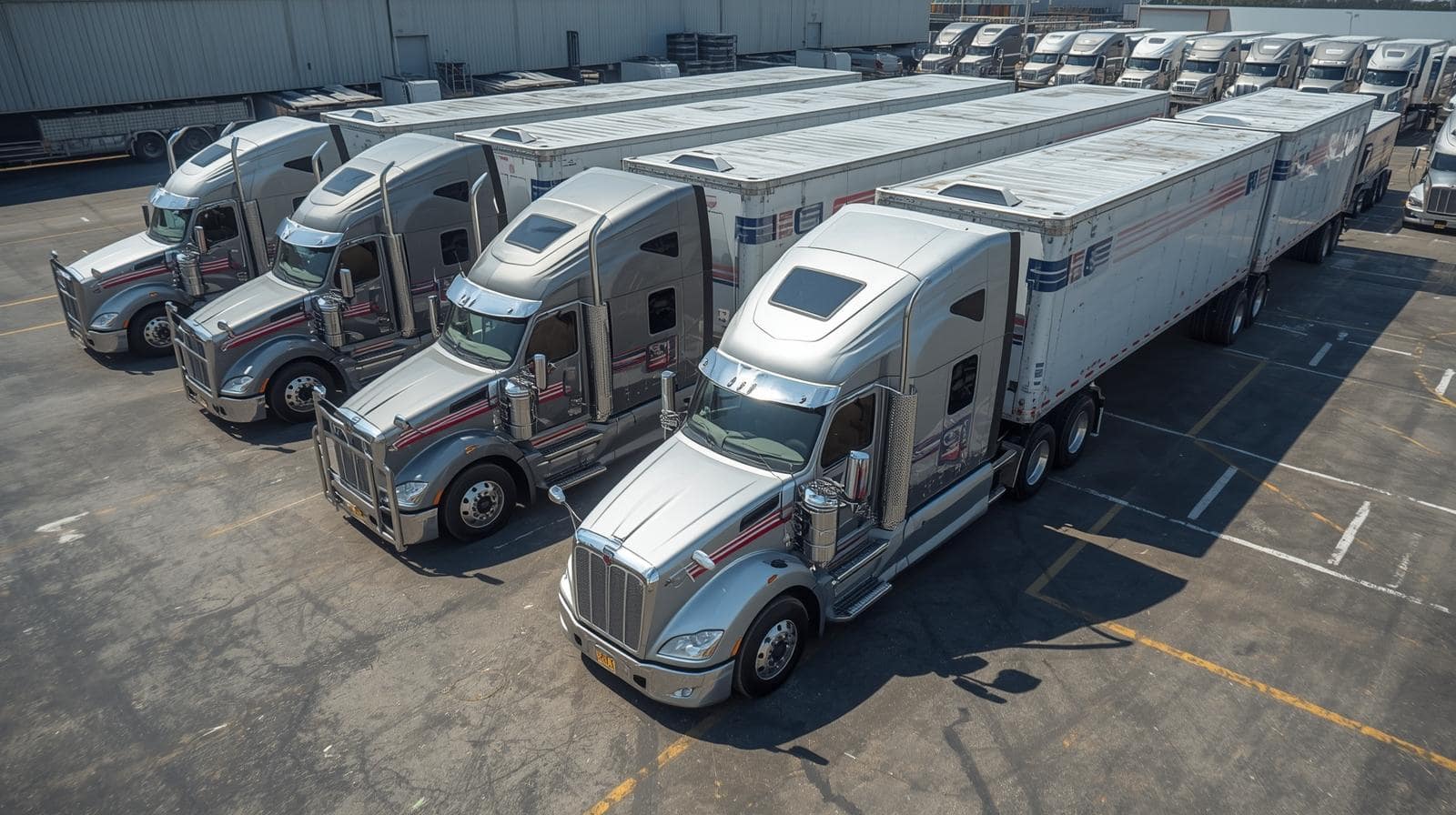Contents
- The Role of Tracking & Analytics in Fleet Management
- Benefits of Data-Driven Fleet Operations
- Key Metrics to Track
- Implementing Fleet Analytics Successfully
- Real-World Success Stories
- Future Trends in Fleet Tracking & Analytics
- FAQ
- What is the difference between tracking and analytics in fleet management?
- How quickly can a business see ROI from fleet analytics?
- Do small fleets benefit from tracking and analytics?
- Will drivers resist being tracked?
- Are fleet analytics systems expensive?
- What metrics should I track first if I’m just starting out?
- How do fleet analytics support sustainability goals?
- Do small fleets benefit from tracking and analytics?
- Will drivers resist being tracked?
- Are fleet analytics systems expensive?
- What metrics should I track first if I’m just starting out?
- How do fleet analytics support sustainability goals?
Fleet management is one of the most resource-intensive aspects of business. Whether you manage a fleet of delivery vans, construction vehicles, or long-haul trucks, efficiency is always the deciding factor between profit and loss. Rising fuel prices, unpredictable traffic patterns, driver shortages, stricter regulatory compliance, and sustainability demands are creating new layers of complexity for fleet managers across industries.
In this environment, relying on intuition or manual methods is no longer enough. Tracking and analytics have emerged as indispensable tools — transforming raw vehicle and driver data into actionable insights that drive down costs, improve performance, and enhance overall operational efficiency.
This article explores the full spectrum of fleet tracking and analytics: their role, the benefits they deliver, key metrics to monitor, implementation strategies, real-world success stories, and future trends. At the end, we’ll also answer common FAQs from businesses beginning their journey into data-driven fleet management.
The Role of Tracking & Analytics in Fleet Management
From Tracking to Insight
At its simplest, fleet tracking provides real-time visibility into where your vehicles are and what they are doing. Analytics, however, takes this one step further — it interprets that data, identifies inefficiencies, and provides actionable recommendations.
- Tracking: A vehicle is idling for 20 minutes.
- Analytics: The same vehicle idles longer than 80% of the fleet, costing $X in wasted fuel each month. Recommendation: driver training or route adjustment.
This distinction is critical. Visibility helps managers respond; analytics empowers them to anticipate and optimize.
Technologies Powering Modern Fleet Analytics
- GPS Tracking: Location, routing, and time-on-road monitoring.
- Telematics: Driver behavior, engine performance, and vehicle diagnostics.
- IoT Sensors: Tire pressure, fuel usage, cargo weight, and more.
- Cloud-Based Dashboards: Centralized data access for managers.
- AI & Machine Learning: Pattern recognition and predictive insights for smarter decisions.
Together, these technologies build an ecosystem where managers don’t just see what’s happening — they understand why it’s happening and how to improve it.
Benefits of Data-Driven Fleet Operations
1. Fuel Efficiency & Cost Savings
Fuel accounts for up to 30–40% of fleet operating expenses. Small inefficiencies add up quickly. With analytics, businesses can:
- Track idling and reduce waste.
- Optimize routes to minimize unnecessary mileage.
- Identify drivers with inefficient driving habits (e.g., harsh acceleration, speeding).
- Spot patterns in refueling to detect theft or misuse.
Case Example: A logistics firm implemented telematics and reduced overall fuel consumption by 15% within six months through route optimization and reduced idling.
2. Preventive & Predictive Maintenance
Traditional maintenance follows a schedule. But not all vehicles experience the same wear and tear. Predictive analytics allows fleets to service vehicles when they need it, not just when the calendar says so.
- Preventive alerts for oil changes, brake wear, or tire pressure.
- Predictive maintenance based on engine health, vibration data, or temperature anomalies.
- Lower repair costs and reduced downtime.
Example: A parcel delivery company reduced unexpected breakdowns by 40% after implementing predictive maintenance tracking.
3. Driver Performance & Safety
Driver behavior has a direct impact on safety, fuel consumption, and brand reputation. Analytics enables:
- Monitoring of speeding, harsh braking, sharp turns, and rapid acceleration.
- Creation of driver scorecards for performance benchmarking.
- Implementation of incentive programs for safe and efficient driving.
The result: fewer accidents, lower insurance premiums, and a stronger safety culture.
4. Route Optimization & Productivity
Analytics-driven route planning doesn’t just find the shortest path — it finds the smartest path.
- Avoids congested areas and adjusts for real-time traffic or weather conditions.
- Optimizes multi-stop deliveries for maximum efficiency.
- Improves time-on-task utilization by reducing unnecessary mileage.
UPS famously saved 10 million gallons of fuel per year simply by using route analytics to minimize left-hand turns.
5. Compliance & Sustainability
Regulations such as electronic logging devices (ELDs), hours-of-service (HOS) tracking, and emissions reporting are increasingly strict. Analytics automates compliance, minimizing administrative burden and risk of violations.
At the same time, sustainability is a growing priority. Tracking helps businesses reduce emissions, implement eco-friendly driving strategies, and measure progress toward ESG (Environmental, Social, and Governance) goals.
Key Metrics to Track
Fleet data can be overwhelming. Success depends on focusing on the most critical KPIs:
- Fuel consumption per mile/km
- Vehicle utilization rate
- Maintenance cost per vehicle
- Driver behavior index (acceleration, braking, idle time)
- On-time delivery percentage
- Downtime (planned vs. unplanned)
- CO₂ emissions per vehicle
Each of these metrics ties directly to cost savings, efficiency, or compliance.
Implementing Fleet Analytics Successfully
Step 1: Define Clear Goals
Do you want to reduce fuel costs by 10%? Extend vehicle lifespan by two years? Improve delivery punctuality? Setting clear targets ensures the right data is prioritized.
Step 2: Select the Right Platform
Key considerations:
- Integration with existing dispatch or ERP systems.
- Scalability to grow with your fleet.
- Ease of use for managers and drivers.
Step 3: Train Teams & Gain Buy-In
Drivers may resist tracking due to concerns about micromanagement. Success depends on framing it as a tool for safety and efficiency — not surveillance. Incentives and recognition programs help build trust.
Step 4: Integrate Insights Into Daily Operations
Analytics must be actionable. For example:
- Automatic maintenance alerts tied to service scheduling.
- Route updates pushed directly to drivers in real time.
- Monthly driver performance reviews based on data-driven scorecards.
Overcoming Challenges
- Data Overload: Focus on the top KPIs; avoid trying to track everything.
- Cultural Resistance: Communicate benefits clearly and involve drivers early.
- Upfront Costs: Emphasize ROI — many fleets recover initial investment within 12–18 months.
Real-World Success Stories
- DHL Express: Reduced fleet CO₂ emissions by 26% by cutting idling times and optimizing deliveries with telematics.
- UPS: Saved $300 million annually through route analytics and advanced driver monitoring.
- Small Fleet Example: A regional courier with just 25 vehicles cut fuel expenses by 12% and improved on-time delivery by 20% after six months of adopting GPS analytics.
Future Trends in Fleet Tracking & Analytics
- AI & Machine Learning: Advanced predictive models will provide smarter maintenance scheduling and route planning.
- Electric Vehicle Analytics: Tracking charging cycles, battery health, and optimizing EV fleet usage.
- Autonomous Fleet Coordination: Analytics will serve as the “nervous system” for self-driving fleets.
- Deeper ESG Integration: Emissions reporting will be standardized, and analytics will play a central role in corporate sustainability initiatives.
FAQ
What is the difference between tracking and analytics in fleet management?
Tracking gives real-time visibility into location and vehicle status. Analytics interprets that data to identify inefficiencies, predict issues, and recommend improvements.
How quickly can a business see ROI from fleet analytics?
Many companies see measurable savings within 6–12 months, particularly in fuel and maintenance costs.
Do small fleets benefit from tracking and analytics?
Absolutely. Even fleets with fewer than 20 vehicles can achieve significant savings in fuel, repairs, and scheduling efficiency.
Will drivers resist being tracked?
Resistance is common initially, but transparency and incentives help. Framing it as a safety and efficiency tool — not surveillance — is key.
Are fleet analytics systems expensive?
Costs vary by provider, but ROI is typically fast. Fuel savings, reduced downtime, and fewer accidents often offset initial expenses quickly.
What metrics should I track first if I’m just starting out?
Start with fuel consumption, vehicle utilization, and driver behavior. These deliver the fastest and most visible impact.
How do fleet analytics support sustainability goals?
By reducing idling, optimizing routes, and tracking emissions, businesses can cut fuel usage and lower CO₂ output — helping meet corporate ESG targets.
Fleet tracking and analytics are no longer optional — they are essential to staying competitive in today’s efficiency-driven economy. By leveraging data, businesses can optimize fuel use, extend vehicle life, improve safety, comply with regulations, and advance sustainability goals.
The fleets of tomorrow won’t simply be the largest or the fastest — they will be the smartest. Organizations that embrace tracking and analytics today will not only cut costs but also build a more resilient, sustainable, and customer-focused operation for the future.
Do small fleets benefit from tracking and analytics?
Absolutely. Even fleets with fewer than 20 vehicles can achieve significant savings in fuel, repairs, and scheduling efficiency.
Will drivers resist being tracked?
Resistance is common initially, but transparency and incentives help. Framing it as a safety and efficiency tool — not surveillance — is key.
Are fleet analytics systems expensive?
Costs vary by provider, but ROI is typically fast. Fuel savings, reduced downtime, and fewer accidents often offset initial expenses quickly.
What metrics should I track first if I’m just starting out?
Start with fuel consumption, vehicle utilization, and driver behavior. These deliver the fastest and most visible impact.
How do fleet analytics support sustainability goals?
By reducing idling, optimizing routes, and tracking emissions, businesses can cut fuel usage and lower CO₂ output — helping meet corporate ESG targets.
Fleet tracking and analytics are no longer optional — they are essential to staying competitive in today’s efficiency-driven economy. By leveraging data, businesses can optimize fuel use, extend vehicle life, improve safety, comply with regulations, and advance sustainability goals.
The fleets of tomorrow won’t simply be the largest or the fastest — they will be the smartest. Organizations that embrace tracking and analytics today will not only cut costs but also build a more resilient, sustainable, and customer-focused operation for the future.










